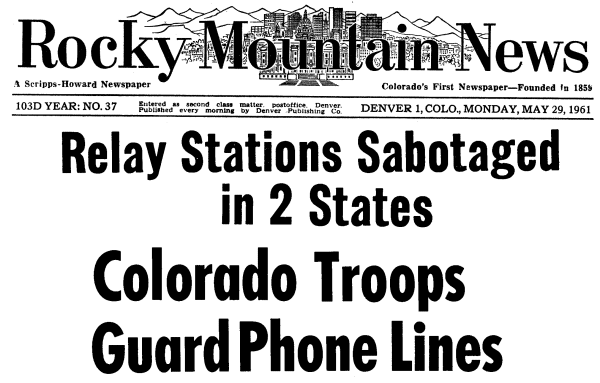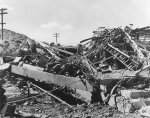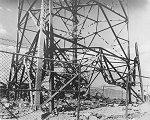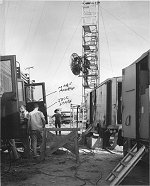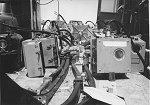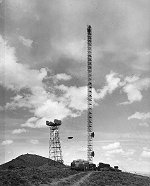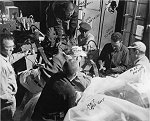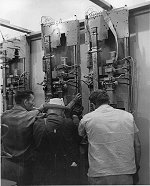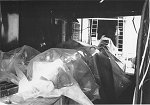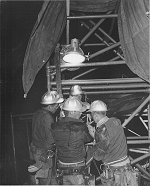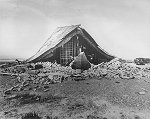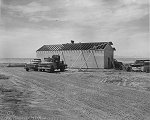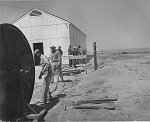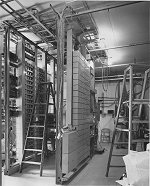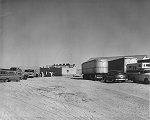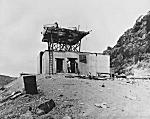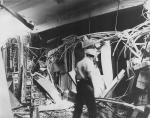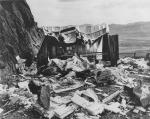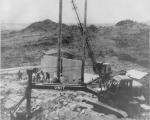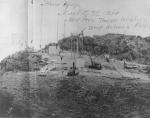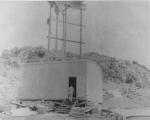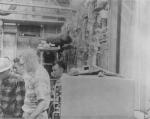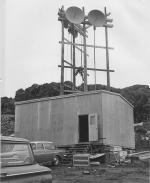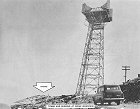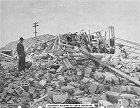Newspaper Stories**
Here are some newspaper clippings of these events:
1 2 3 4 5 6 7 8 9 10 11 12 13 14
Cedar Mountain
(click on thumbnail images to enlarge)
This following information is a combination of what I collected and recollections having participated in the restoration of Cedar Mountain Utah radio relay station in 1961 and Walt Petersons information that no doubt was used to justify the construction of the first radio relay restoration vans. As a result, a number of td-2 (4 GHZ) restoration vans were built by Western Electric under the direction of the Midwestern Area Engineering Dept. Later when the radio was installed in the area, a TH (6GHZ) restoration van was built. It is doubtful that until the bombings much thought given to restoration of microwave equipment. The expectation of a downed tower was most likely the major consideration for restoration until the Utah & Nevada bombings. There were portable towers available but the only portable 4GHZ microwave equipment in the Midwestern region was TE radio. This used mostly for microwave path testing. Since we maintained TE radio at Davenport Ia. central office, Marv Fagerli and I were sent to Cedar Mountain to assist in the restoration. JACK STAES
Explosion Damage - May 28. Reinforced concrete beam with remains of one TD-2 Radio Bay laying on them.
This was taken the day after the explosions. It was thought that perpetrators gained access into the building through a roof hatch so as not to set off a door alarm. Also that in order to cause such a complete destruction of the building the fresh air intake was blocked so the blast would knock out the walls.
When the charges were detonated the tower dropped about 20 feet, remained upright but leaning toward the west.
The tower legs were secured to the base, later the top portion was dismantled.
This was some of the exploded and unexploded bomb material that was collected.
May 30 - The TE trucks in place and starting the wave guide runs.
Complete restoration of the site, was to be accomplished in three phases. Phase I would restore service using portable TE equipment and the temporary tower. Phase II would cut over to a temporary building equipped with TD-2 equipment installed by Western Electric installers using the temporary tower. Phase III would cut service over to a new building, TD-2 equipment and new tower. When we arrived 2 days after the explosions, building and equipment debris had been pushed over the side of the mountain to make room for restoration activities. Vans with TE radio equipment and more Midwestern area personnel were arriving. The US Air force flew in two vans and personnel from Richmond Va. AT&T construction personnel had almost completed the temporary tower. Contractors were about complete with the temporary building for phase II.
The vans were positioned so that the control panels installed in the trailers could be connected to transmit and receive power heads. The RF connections were made to the common wave-guide runs (i.e. transmit or receive E-W or W-E) using channel-combining networks. Some piece parts needed were scrounged off equipment over the side of the mountain.
Raising the west parabolic reflector.
AT&T construction installing antennas. Continuity was established by 10:05PM.
June 1. W.J. MacDonald Equipment MTC. Sup. Richmond, VA adjusting TE, RF heads.
On the third day channels were cut into common runs and turned up for service.
June 1. Western Electric installers placing TD-2 bays in Phase 2 building.
Western Electric worked day and night installing td-2 equipment in the phase II building.
TE radio equipment was not tolerant of the daytime heat and nighttime cold. This caused the TE equipment drift in frequency. Wrapping the power heads tended to stabilize the temperature and protected the unit from the weather.
By 11:00PM of the 6th day, Western Electric had completed installation of td-2 equipment in the phase II building and the wave-guide was cut over from the TE equipment to the phase II equipment.
K7
(click on thumbnail images to enlarge)
May 28. First view of explosion damage at Knolls “K” repeater station. The roof is resting on equipment bays.
K7W. May 30. Phase II building under construction. Portable alternator on truck.
K7W. June 1. Laying in cable to Phase II building.
K7W. June 4. Completion of “K” repeater cabling by Western Electric Co.
K7W. June 17. Walls near completion for Phase III building.
Wendover
(click on thumbnail images to enlarge)
May 28. Explosion damage. Wendover radio station immediately after explosion. Two of the four antennae were severed from supports and hurled from tower.
May 28. Explosion damage. Damaged equipments bays and battery cells.
May 28. Explosion damage. Demolished antennae and storage shed. Spare engine - alternator not damaged extensively.
May 30. Phase I. Construction of Phase II building and Phase III tower footings.
May 31. Phase I. Phase II building and tower construction.
June 3. Phase I. Phase II TD-2 radio bays - construction nearing completion.
June 4. Phase II. Phase II in operation. Construction workers securing wave guide runs.
The following scans and text were sent by Terry Michaels of Tower Sites, Inc. They were scanned from the June 30, 1961 Radio Notes internal publication of Long Lines.
Permanent Restoration of Repeater Stations
On July 3, 1961 the TD-2 repeater stations at Cedar Mountain, Utah and Wendover, Nevada, were restored to permanent operation 35 days after an explosion destroyed them on May 28. The new facilities replace the temporary arrangements that had been quickly se up following the disaster, including temporary towers and wooden buildings to house the equipment.
On July 5 the K carrier repeater station at Knolls, Utah was restored to permanent operation.
EXPLOSIONS DESTROY REPEATER STATIONS
Early Sunday morning, May 28th, the TD-2 repeater stations at Cedar Mountain, Utah and Wendover, Nevada and the K carrier repeater station at Knolls, Utah were blown up and virtually destroyed, severing both the central transcontinental microwave and K carrier routes. Cedar Mountain is the second and Wendover the first TD-2 repeater station west of Salt Lake City. More than 2200 telephone and telegraph circuits and two television channels were interrupted.
Many private line circuits were made good within a short time and the first TD-2 systems were rerouted around the damaged section by way of Los Angeles within two hours. By Sunday evening, most of the circuits had been rerouted spare facilities and protection radio channels. One TD-2 channel was made available between Salt Lake City Junction and Los Angeles (via Turquoise) Tuesday night, May 30th, by expediting installation of new equipment on which work was nearing completion. This released some protection channels that had been used for reroutes.
Portable TE equipment was brought in to restore service across the breaks. By June 2nd, four two-way TE repeaters had been set up at each of the microwave locations to restore two message, one television, and one protection channel. Portable scaffolding type towers were used to support the antennas.
Within one week after the blasts, temporary wooden buildings were constructed and six two-way AC-operated TD-2 were installed at each station to maintain normal service until a permanent one can be made. The temporary towers with parabolic antennas will be used until permanent towers and can be replaced. Permanent of the TD-2 stations is expected to be completed by July 18.
According to recent news reports, the FBI believes the sabotage was the work of two men who stated their intention was to destroy cartels, such as the American Telephone and Telegraph Company, and to focus attention on an organization called “American Republican Army” which advocates political overthrow of the United States.
Pictures are attached showing the destruction at the Wendover and Cedar Mountain locations.
Click to enlarge
Click to enlarge





Reliable, secure high-speed internet
With CenturyLink Simply Unlimited Internet, you can choose from a wide range of available speeds that fit your online needs. Plus, you can connect several devices with super-fast in-home WiFi.
Order Now

